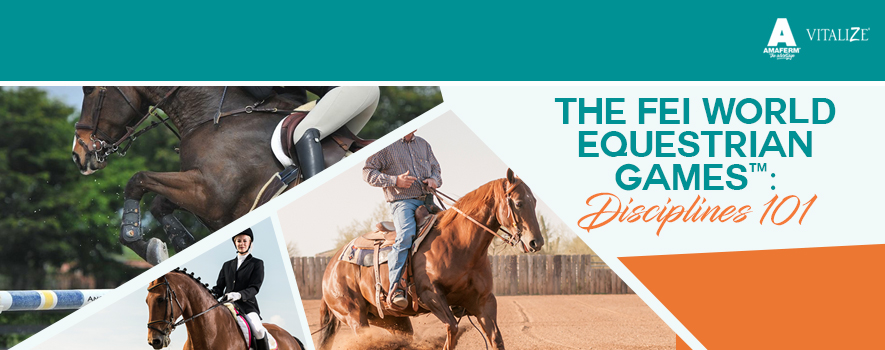
The FEI World Equestrian Games™ is a global phenomenon that combines eight equestrian sports and is held every four years in the middle of the Olympic calendar season. This September, it will be held at the Tryon International Equestrian Center in Mill Spring, North Carolina! Although it is one of the most popular equine events in the world, most equine enthusiasts go to attend only one sport, and they may not understand the other seven.
Dressage: “Ballet of the Horse”
Dressage is often coined “ballet of the horse,” which is quite accurate if you find yourself watching this event at the Games™. The horse and rider must complete a test comprised of specific movements, and their performance is scored similarly to ice skating with a seven-member judging panel. The horses are so well trained that you can hardly tell the rider is instructing them to do anything. Dressage begins September 12th and concludes on September 16th with an Individual Freestyle, my personal favorite event where the rider choreographs a routine to music. Sit back and enjoy ballet of the horse!
Endurance: “The Long Haul”
Endurance is much like a marathon for horse and rider; it tests their speed, energy and navigational skills while traveling through Tryon’s natural terrain for 100 miles. Vet checks and rest periods are crucial in this sport to ensure safety for both horse and rider. Endurance will be held on September 12th with a Medal Ceremony on September 13th.
Jumping: “Where Precision Meets Speed”
Jumping is an obstacle course of fences which requires a combination of precision, speed, athleticism and sometimes a little luck! Penalties occur when the horse and rider complete the course to slowly, known as time faults (1 fault for every 4 seconds over time allowed), or lower the fence height, known as jumping faults (4 faults for each fence). Jump heights will range from 1.55-1.65m (5’1”-5’5”) with spreads reaching 2m (6’6”). There will be an individual and team component of this sport, which begins September 19th and concludes September 23rd.
Eventing: “The Horse’s Triathlon”
While Endurance is a “marathon”, Eventing is a “triathlon” for the horse and rider. Pairs compete in three sections: Dressage, Cross-Country, and Jumping. In Dressage, the competitors ride a test demonstrating movements judged from 0 to 10. Cross-Country is a timed jumping course over 2-4 miles with natural obstacles such as ditches, large jumps, water and banks. Finally, the last portion of the triathlon is show-jumping, a jumping course held in an arena that is based on speed and accuracy. If a team is too slow, a time fault is added for every second over the time allowed, however if the fence height is lowered, 4 faults are added to the score. Eventing begins September 13th and ends September 16th.
Driving: “Eventing… but with a Carriage!”
Driving, similar to Eventing, is separated into 3 sections—Dressage, Marathon and Obstacle/Cones—and involves a 4-in-hand horse-drawn carriage navigated by a team of 3 people. Dressage is similar to conventional Dressage, where the horses must perform a test of seamless movements while also being judged on appearance. “Marathon” is similar to cross-country, where the squad must navigate through terrain to test their stamina and athleticism. Obstacle/Cones is a test of precision, especially following the other two events. Driving will be held over three days, starting September 21st and ending September 23rd.
Para-Dressage: “Equestrian Athletes with Disabilities”
Para-Dressage was added to the FEI disciplines in 2006 and is judged on the same basic rules of conventional Dressage. However, each rider has a different level of physical functionality. In this sport, each rider is selected based on a Classification Profile developed by Dr. Christine Meaden where riders are put in different “grades” based on physical abilities and tested accordingly. Para-Dressage has an individual and team component which commences September 18th and concludes September 22nd.
Reining: “Ranch Horse meets Dressage”
Reining is a thrilling western event that combines spins, circles, lead changes and sliding stops originating from working cattle with the precision of challenging dressage movements. It is all held within an arena and scored with each rider beginning at 70 (average), according to the AQHA Handbook. It also notes, “points will be added or subtracted from the maneuvers… ranging from plus 1.5 to minus 1.5 : -1.5 extremely poor, -1 very poor, -0.5 poor, 0 average, +0.5 good, +1 very good, +1.5 excellent.” There will be 5 judges, and each pair will have the top and bottom score dropped to create an average. Fun fact? Reining is the only western discipline in the Games! Reining begins September 12th and concludes September 15th.
Vaulting: “Gymnastics on Horseback”
Did you know Vaulting goes back nearly two thousand years? Otherwise known as “gymnastics on horseback,” the ancient sport shows both the athletic abilities of the acrobats while also testing the mentality of the horse. Vaulters will jump on the back (from the ground!) of a horse cantering on a lunge line to perform their routine… can you imagine? Routines range from team, individual, and freestyle and begin September 18th.
The FEI World Equestrian Games™ begins with an Opening Ceremony next week, September 11th, and concludes September 23rd. Check back with us all this month for more info, blogs, and interviews centered around #WEG!

